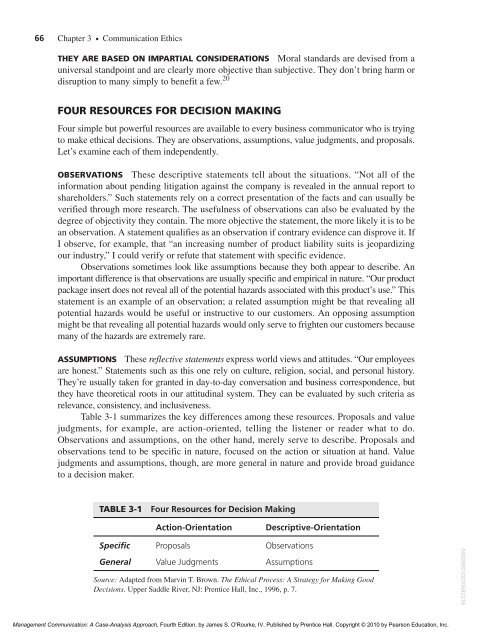MANAGEMENT COMMUNICATION - Pearson Learning Solutions
MANAGEMENT COMMUNICATION - Pearson Learning Solutions
MANAGEMENT COMMUNICATION - Pearson Learning Solutions
Create successful ePaper yourself
Turn your PDF publications into a flip-book with our unique Google optimized e-Paper software.
66 Chapter 3 ● Communication EthicsTHEY ARE BASED ON IMPARTIAL CONSIDERATIONS Moral standards are devised from auniversal standpoint and are clearly more objective than subjective. They don’t bring harm ordisruption to many simply to benefit a few. 20FOUR RESOURCES FOR DECISION MAKINGFour simple but powerful resources are available to every business communicator who is tryingto make ethical decisions. They are observations, assumptions, value judgments, and proposals.Let’s examine each of them independently.OBSERVATIONS These descriptive statements tell about the situations. “Not all of theinformation about pending litigation against the company is revealed in the annual report toshareholders.” Such statements rely on a correct presentation of the facts and can usually beverified through more research. The usefulness of observations can also be evaluated by thedegree of objectivity they contain. The more objective the statement, the more likely it is to bean observation. A statement qualifies as an observation if contrary evidence can disprove it. IfI observe, for example, that “an increasing number of product liability suits is jeopardizingour industry,” I could verify or refute that statement with specific evidence.Observations sometimes look like assumptions because they both appear to describe. Animportant difference is that observations are usually specific and empirical in nature. “Our productpackage insert does not reveal all of the potential hazards associated with this product’s use.” Thisstatement is an example of an observation; a related assumption might be that revealing allpotential hazards would be useful or instructive to our customers. An opposing assumptionmight be that revealing all potential hazards would only serve to frighten our customers becausemany of the hazards are extremely rare.ASSUMPTIONS These reflective statements express world views and attitudes. “Our employeesare honest.” Statements such as this one rely on culture, religion, social, and personal history.They’re usually taken for granted in day-to-day conversation and business correspondence, butthey have theoretical roots in our attitudinal system. They can be evaluated by such criteria asrelevance, consistency, and inclusiveness.Table 3-1 summarizes the key differences among these resources. Proposals and valuejudgments, for example, are action-oriented, telling the listener or reader what to do.Observations and assumptions, on the other hand, merely serve to describe. Proposals andobservations tend to be specific in nature, focused on the action or situation at hand. Valuejudgments and assumptions, though, are more general in nature and provide broad guidanceto a decision maker.TABLE 3-1Four Resources for Decision MakingAction-OrientationDescriptive-OrientationSpecific Proposals ObservationsGeneral Value Judgments AssumptionsSource: Adapted from Marvin T. Brown. The Ethical Process: A Strategy for Making GoodDecisions. Upper Saddle River, NJ: Prentice Hall, Inc., 1996, p. 7.000200010270582216Management Communication: A Case-Analysis Approach, Fourth Edition, by James S. O'Rourke, IV. Published by Prentice Hall. Copyright © 2010 by <strong>Pearson</strong> Education, Inc.

















